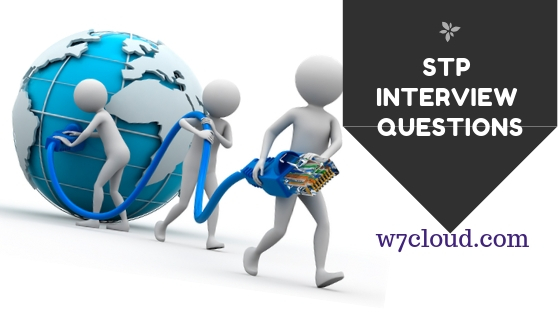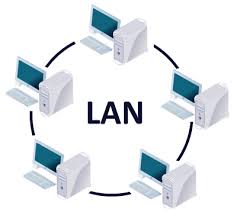
Top Networking Interview Questions and Answers 2022
Here are top Networking Interview Questions and Answers, which will help your network Job’s interview in 2022.
Question#1:What is OSI model?
Answer: The OSI (Open Systems Interconnection) model define the process of networking between the two devices in terms of layers.
- Application layer
- Presentation layer
- Session layer
- Transport layer
- Network layer
- Data link layer
- Physical layer
In the OSI model, data flow starts from the top layer at the sending side, travels down the OSI model’s layers to the physical layer and then on receiving side data goes up from physical to application layer of OSI model stack.
For more details you can visit OSI network Model
Question#2: What is DNS?
Answer: The DNS stand for domain name system and it is an internet service or protocol that resolves IP address into domain/device name and vice versa. It is difficult to remember the IP addresses of each host but with DNS you have the alphabetic-names and they are easier to remember. For example, the domain name www.w7cloud.com has the IP address 203.124.114.1, with DNS you can access it with its name that is w7cloud.com. Similarly in LAN environment you can resolve IP addresses of computers into system-names for example you access a system named “marketing-PC” by its name instead of it IP address 192.168.1.3.
Question#3: What is DNS reverse Zone?
Answer: The DNS reverse zone resolve IP address into a device name.
Question#4: What is DNS Forward Zone?
Answer: The DNS reverse zone resolve domain name into IP subnet or IP address.
What is DHCP?
Dynamic host configuration protocol assigns the IP settings automatically to hosts/computers and other network devices like IP phones. In presence of DHCP you don’t need to manually assign an IP address, every network device is assigned with an IP by DHCP from DHCP IP range/pool.
What is ICMP?
Normally work with Ping protocol, provide different message like echo reply, request time out destination unreachable etc. Internet Control Message Protocol (ICMP) is an error reporting and diagnostic utility and is considered a required part of any IP implementation.
What is ARP and reverse ARP?
ARP stand for address resolution protocol, and provide the IP address against a MAC address when data packets/frames wants to move from layer2 to layer3.
Reverse ARP
Reverse ARP perform the reverse resolution, it resolve or provide the MAC address against the IP address.
What is switch and router? Differences between switch and router?
Normally router is the layer3 device which forwards the packets base on IP address and considers making communication between the two networks. Router performs the packet switching.
Whereas switch is consider as a layer2 device deal with the MAC address and forwards the packets base on MAC address. Switches perform the circuit switching which is faster as compare to packet switching.
Difference Between L3 switch and router: (An Important Networking Interview Questions)
What is the Difference between hub and switch?
Hub is physical layer device and use the broadcast to transmit its data, mean wherever hub want to send a data to some destination its will transmit/send data on its each and every port.
On the other hand switch is more intelligent, forward the packet base on MAC address, it do the broadcast once then build its MAC table and next time it forward the packets directly to destination according to MAC address route or path.
What is cross and straight cables?
This Ethernet network cable is made of 4 pair high performance cable that consists of twisted pair conductors that used for data transmission. Both end of cable is called RJ45 connector. There are two most commonly used Ethernet cable types which are as following.
Usually use straight cable to connect different type of devices, the device which are on different OSI-layer for example you can connect a PC with switch using straight cable.
RJ451 Connected to RJ452
Pin1 –> Pin1
Pin2 –> Pin2
Pin3 –> Pin3
Pin4 –> Pin4
Pin5 –> Pin5
Pin6 –> Pin6
Pin7 –> Pin7
Pin8 –> Pin8
Cross cable used to connect same type of devices/ devices on same layer of OSI-layer. For example you can Connect two computers directly with cross cable.
RJ451 Connected to RJ452
Pin1 –> Pin3
Pin2 –> Pin6
Pin3 –> Pin1
Pin4 –> Pin4
Pin5 –> Pin5
Pin6 –> Pin2
Pin7 –> Pin7
Pin8 –> Pin8
What is difference between routing and routed protocols?
Routing protocols define the path for forwarding packets; they find the best path for each destination using different programming algorithms. Example of routing protocols includes OSPF, RIP, EIGRP and IS-IS. You can also learn about best routing protocol. (An Important Networking Interview Questions)
EIGRP Interview Question with detailed Answers
Routed protocols:
Routed protocols carry the actual data using the routing protocols for example IP is the routed protocol. Cisco defines the routed protocol as “a protocol by which data can be routed”. IP, AppleTalk, and IPX are examples of routed protocols.
What is VPN?
VPN stand for the virtual private network and now days it is considered to the best solution or most secure way for connecting the remote users or site offices to main office. VPN create a virtual tunnel through the service provide network or through internet cloud and provide you the secure connectivity to remote offices. You can learn more about VPNs.
What is IPSec?
IP Sec is the group of security protocols for securing the IP communication. Security protocols includes like authentication protocols, encryption, etc.
What is Subnetting and its advantages?
Subnetting is used for dividing the large IP-network into smaller sub network which are called subnets, also known as the variable length subnet mask. It has the numerous advantages like:
- By subnetting you can utilize the maximum number of network.
- You can divide you network into different sub-network which provide you security and easy management of IP addresses.
- By subnetting you can reduce the size of routing tables in a large internetwork.
What are the Public and private IPs?
Private IP addresses are used within LAN or MAN, you cannot route the private IP addresses over the internet. These IP are only used for building the internal network and cannot be accessible from over the internet. Following are the private IP addresses ranges from different IP classes:
| First IP in block | Last IP in block | Network Size |
| 10.0.0.0 | 10.255.255.255 | You can used it for larger LAN |
| 172.16.0.0 | 172.31.255.255 | Suitable for medium network. |
| 192.168.0.0 | 192.168.255.255 | Small network |
The Public IP addresses are the live IP address and router over the internet, also accessible from anywhere. Our all internet traffic and communication is based on Public IPs, on internet every website and server have public IPs due to which they are accessible from anywhere via internet.
What is collision domain, broadcast domain?
Collision domain is number of device which can send/receive data at the same time, for example 12 ports switch have 12 collision domains. Whereas the broadcast domain can be within the same LAN segment and whenever a broadcast frame is sent, all computers on the broadcast domain receive the frame.
(It an old but still famous Networking Interview Questions for beginners)
What is Multicasting or multicast??
In Multicast data or information is transferred from one to many, it is the advance version of broadcast in which you define a multicast group and wherever you transmit information on this multicast group everyone belong to this group can have this information.
What is NAT?
Network address translation is useful protocol for mapping the public IPs on private IPs and vice versa. We know that our private IP addresses are not capable for routing our data over the internet, for internet traffic we have the public IP addresses. NAT made the mapping of private IP address on the single or multiple public IP addresses, by which a user having private IP address on LAN can send his request over the internet.
What is firewall?
A firewall is a device or a program that protects the resources of a private network from users from other networks/threats /attacks.
What is difference between UDP and TCP?
| TCP | UDP |
| TCP is connection orient, mean you need to create the connection first for communication. | UDP is connectionless communication; you can send the data without creating the connection. |
| TCP is reliable because of its connection oriented nature; you have the guaranty for delivering your information. | UDP suppose to be unreliable because of its connection less nature. |
What is difference between Packet-Switched VS Circuit-Switched Networks?
In packet switch before the communication you don’t have the full path for transmitting data, data is divide into different chunks and route on per-node basic, Whereas in Circuit Switch you have a dedicated path for communication, path is decided before the communication. Circuit switch is faster than packet switching. (Very Important Networking Interview Questions)
Networking Questions related to Routing protocols:
What are routing protocols? Name some famous ones?
Routing protocols perform the layer-3 communication by finding the best path for all destinations. There are two type of routing protocols one type is distance vector protocol and other type is link state routing protocols.
Some of famous routing protocols are the RIP (Routing Information Protocol), OSPF (Open Shortest Path First), EIGRP (Enhance intererial Gateway routing protocol), BGP (Border Gateway protocol) and IS-IS.
(Important Networking Interview Questions for beginners)
What is default gateway?
Default gateway is used for handling the request for unknown network (the network which is not present in routing table).
What are static route?
When you define or tell a path for a specific destination to router with its source IP, destination IP and with subnet-mask without using any routing protocol is called static route.
What is Difference between IGP and EGP protocols?
Interior Gateway protocols are used for communication within one autonomous system or within LAN/MAN. RIP and EIGRP are the example of IGP protocols.
EGPs (Exterior Gateway Protocols) are used to make the communication between different autonomous system and between different IGPs. BGP is the example of EGP.
(Important Networking Interview Questions for beginners)
What is difference between distance vector and link-state routing protocols?
Distance vector protocols find the best path base on hop-count, a path with less hop-count is consider to be best path for a distance vector protocol even there are some slow speed links.
Link-State routing protocols are more intelligent and they used some better programming algorithm for choosing the best path, link-state routing protocols find the best path by determining different factors like bandwidth and delay for a link/path/route. They are three types of tables in link state routing protocols
- neighbor table
- topology table
- routing table
What is difference between OSPF and EIGRP?
| OSPF | EIGRP |
| OSPF is link-state routing protocol. | EIGRP is distance vector protocol. |
| OSPF is open standard and you can run it on any vendor for example Cisco, Huwaei and juniper. | EIGRP is Cisco proprietary protocol. |
| Keep the entire route-map of all area in its topology table. | There is topology table but don’t have complete route map. |
| Use the SPF algorithm for finding the best path. | EIGRP is distance vector protocol. |
| You can divide the OSPF network into different area and can make the smaller routing table. | There is no concept of areas in OSPF. |
What is Difference RIP and RIP v2?
RIP version 2 is the modified or updated version of RIP v1 which support IPV6, VLMS (subnetting) and authentication. In RIPv1 you cant performed subnetting,
What is Administrative distance?
Every routing protocol has the administrative distance, it is a numeric number and router preferred or selects the best route/path base on the lowest administrative distance. You can find Administrative distances of all routing protocols from this link.
(Important Networking Interview Questions for beginners)
Network Questions related to Switching:
What is CDP?
CDP (Cisco Discovery protocol) determine the connected neighbor to a router and provide the different detail related for connected devices.
What are STP and RSTP?
Spanning tree protocol is a Cisco proprietary switching protocol. STP prevents loops when switches are connected each other with multiple links for redundancy purpose. STP removes the loops in Ethernet network by shutting down the extra port.
What is Rapid STP?
Rapid spanning tree is advance version of STP which provides you faster spanning tree convergence after a topology change.
(Cisco Networking Interview Questions for beginners)
What is VLAN and its Advantage?
A switch or switching network may be divided into multiple distinct broadcast domains. Which are mutually isolated that packets can only pass between them with one or more routers. These types of domains are called Virtual LAN or VLAN.
VLAN have many advantages like:
- You can isolate different types of traffic like voice, video and data traffic with VALNs.
- Provide security and privacy between different VLANs.
- VLAN divide a switch into different broadcast domains.
- You can use different IP scheme among different VLANs.
(This is the most asked Networking Interview Questions)
What is VTP?
VLAN trunking protocol is used for transferring the VLANs database among different switches in a switching network. VTP is used for managing VLANs, VTP reduces administration in a switched network. Configure a new VLAN on VTP server will distributed VLAN database to all switches in the domain.
Networking Questions related to Microsoft:
What is ISA SERVER? Exchange server? Microsoft active directory
ISA Server:
ISA Server is used for web caching and web filtering. But you can use ISA server as a network router, firewall, antivirus program, VPN server and web cache.
Exchange server:
Exchange server is email server from Microsoft.
What is an organizational unit in active directory?
Organizational units are created for management of active directory users; you can create different OU like marketing, HR, IT etc. for your company and can implement different group policies on these OU according to department requirements. You can learn more about Organization unit in Active Directory.
What is group policy?
In Active directory group policy is used for applying different rules/policies on organization units. You can learn more about group policy.
Practical Questions related to networking
What type of network currently you have and what are your responsibilities??
You can answerit by sharing your company’s network and your responsibilities, try to highlight the responsibilities which are required for this new job.
Do you ever configure VPNs?
Share your experience. You can answer it by explaining your experience. (An Important Networking Interview Questions)
Do you work on Microsoft active directory?
In answer you can share your experience. (Most asked Networking Interview Questions)














